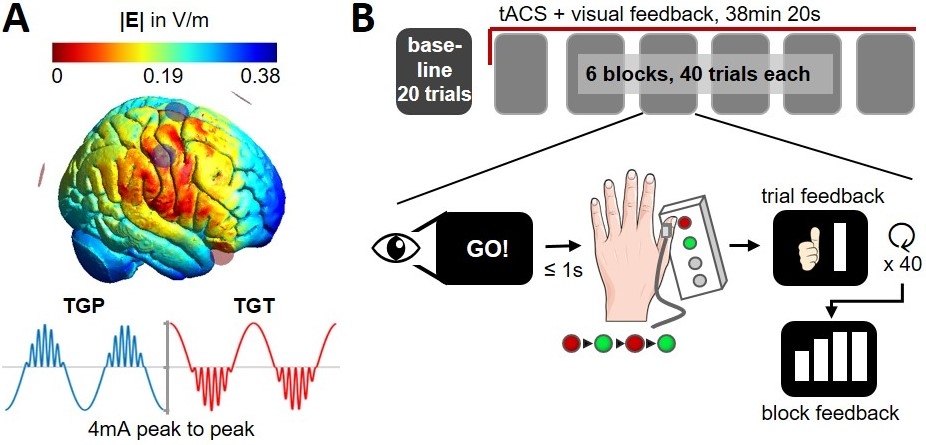Introduction: Theta-gamma (θ-γ) phase amplitude coupling is a widespread phenomenon across the cerebral cortex associated with various aspects of memory and learning (1), but also with motor skill acquisition (2,3). Applying transcranial alternating current stimulation (tACS), a technique thought to entrain oscillations in targeted brain regions (4), with a peak-coupled θ-γ waveform, Akkad et al. enhanced motor skill acquisition in a thumb acceleration task in healthy participants (3).
Objectives: We aim to further investigate if θ-γ tACS enhances motor skill acquisition in healthy individuals by re-studying the idea of Akkad et al. (3) in an extended thumb movement task. Moreover, we study the effect of θ-γ tACS in chronic stroke patients with a history of impaired hand motor function.
Methods: We conducted two randomized, triple-blinded, sham-controlled studies, including 78 healthy volunteers and 20 chronic stroke patients. In our motor skill acquisition task, participants repeatedly pressed a sequence of buttons with their thumb as fast as possible [Fig.1B]. After a pre-tACS baseline, they received peak-coupled θ-γ tACS (TGP) or sham stimulation over M1 throughout 6 task blocks. An active control group in the healthy cohort received trough-coupled θ-γ tACS (TGT) [Fig.1A]. For exploratory analyses, we measured the thumb acceleration. Our primary outcome measure motor skill acquisition, the relative reduction of the performance measure movement duration over the task, was compared between conditions using unpaired t-tests or Wilcoxon rank-sum tests. The effects of condition and block on movement duration and peak acceleration were analyzed in linear mixed-effects models (LME). At the date of abstract submission, the authors are blinded to the tACS conditions. The studies were pre-registered on https://osf.io/mqwt5 and clinicialtrials.gov (Identifier: NCT05576129).
Results: In both cohorts, participants showed an improvement in movement duration over the task. The primary outcome measure motor skill acquisition differed significantly between tACS conditions in stroke patients (t(13.7)=2.71, p=0.017), but not in the healthy cohort (all uncorrected p>0.05) [Fig.2]. Coherently, the condition x block interaction effect on movement duration was significant (likelihood ratio test (LRT): X²(1)=13.5, p<0.001) with post-hoc analyses revealing a difference in slopes between conditions (p<0.001, 95% CI [13.3, 39.6]) in stroke patients but not in the healthy cohort (LRT: X²(2)=2.36, p=0.31). In contrast, in an exploratory analysis, we found a significant effect of condition on peak acceleration in the healthy (LRT: X²(2)=10.15, p=0.006), but not in stroke patients (LRT: X²(1)=0.07, p=0.79).
Conclusion: Theta-gamma tACS impacted how much chronic stroke patients improved their performance while practicing a thumb movement task, but did not show this effect in young healthy individuals. However, only in healthy participants, but not in stroke patients, θ-γ tACS modulated thumb acceleration. The observed qualitatively different effects may help to draw conclusions on neurophysiological differences between optimally functioning and lesioned networks relevant to motor skill acquisition.
Figure 1 Experimental design. (A) Top: electric field simulation from SimNIBS (5), below: tACS waveforms. (B) Motor skill acquisition task.
Figure 2 Results. Movement duration: timeline for each tACS condition. Motor skill acquisition: statistical significance of the pairwise comparisons indicated (n.s.: not significant, *: p<0.05).


